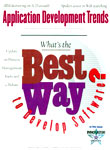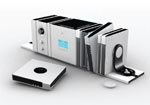Columns
What's up
APPLES TO APPLES
When researchers at Duke looked into the widely held
assumption that universities in India and China were
graduating more engineers than the U.S., the numbers
told a different story.
The researchers examined the annual production of
bachelor’s and subbaccalaureate engineering, CS and
IT degrees awarded in China, India and the U.S. in
2004. The subbaccalaureate category included shortcycle
degrees in China, associate’s degrees in the U.S.
and 3-year diplomas in India.
The number of engineering graduates in the U.S. was
relatively easy to track, although the National Center
for Education Statistics tallied different numbers
based on the way they classify engineering grads. The
lack of comparable information from India and China,
where the term “engineer” is loosely translated, made
the international numbers harder to verify.
What’s the upshot of Duke’s research? The data
suggests the U.S. annually awards 750 bachelor’s and
subbaccalaureate degrees per 1 million citizens, compared
with 500 in China and 200 in India, according
to Duke.
HYPOMETER

If wearing your Nike running
shoes, Izod polo shirt, Levi’s jeans
and Nike baseball jacket aren’t enough to
make you look like a walking billboard, Laptop Design
USA has an idea that will peg the needle on your Hypometer.
The company will paint the lid of your laptop with your brand of choice,
with a company’s colors, logos and trademarks.
GAME PLAY
Think you know enough to run an IT shop? One way to find out is to try the
Intel IT Manager Game on Intel’s U.K. site. The game purportedly tests your IT
expertise and leadership skills. You must manage the IT department—juggling
equipment, human resources and your budget to create the most streamlined
and profitable company possible. Here’s where to try it.
10 YEARS AGO

Ten years ago, Harvard University
won first place in the enterprise
client/server development category
of the ADT Innovator Awards by
following the money. The university
needed infrastructure to support
a $2-billion fundraising campaign.
Each college within the university
used its own computer systems.
To get information on alumni,
fundraisers needed to fill out a
request form and bring it to the
alumni office for processing.
Development Computer Services
at Harvard solved the problem
by building a university-wide
client/server system using a Sybase
System 10 relational database, Solaris
running on Sun’s 690MP—
McNealy is a Harvard grad—and
Blyth Software’s Omnis
7 to build Windows and
Mac front ends. The result:
Fundraisers raised
more than $1 billion in
less than 2 years.
Developers at ShowTime Networks who
created a client/server,
object-oriented, intellectual
property management system
to help manage multimedia and
other intellectual assets associated
with movies, production and talent
won in the object-oriented development
category.
Long-distance telephone services
provider Sprint won in the data
warehousing category for building
a management information data
warehouse to aid its
marketing efforts.
In the wake of the
Telecommunications
Act of 1996, Jill K.
Norris, director of
Decision Support
Services, commented, “Nowadays, it’s a
jungle out there.”
Finally, Gulf Insurance’s information
system analysts and modelers
developed architecture to support
several processes in claims management
to place first in software
engineering. The architecture, the
result of joint application design
sessions with business managers,
was a three-tier client/server platform,
using OS/2 on clients.
BUY THE NUMBERS
Hourly wages for highly skilled technology
professionals hit record levels in the
fourth quarter of 2005, according to the
latest Yoh’s Index of TechnologyWages.
In the fourth quarter, wages increased
3.1 percent overall, when compared to
the same quarter in 2004, Yoh says.
Wages reached a peak average in the
quarter of $30.27 per hour.
The jobs in greatest demand nationwide
during the fourth quarter of 2005,
and their average hourly pay rates as
determined by the Yoh Index, are:
Clinical Research
Associate
$38.52
Data Manager
$45.06
CRM Project Manager
$62.01
Data Warehouse Architect
$69.03
Hardware/Firmware Engineer
$59.34
.NET Developer
$45.77
Oracle Database
Administrator
$55.82
Project Manager
$57.07
SAP Functional Consultant
$75.09
Senior Scientist
$43.76
NOVEL TRUTH

Dan Brown’s novel, Angels & Demons, featuring Harvard
symbologist Robert Langdon, is a high-tech drama that
foreshadows his bestseller, The Da Vinci Code. A prominent
physicist is found murdered with an ambigram—a
word designed to be read rightside up and upside
down—carved into his chest. The ambigram is Illuminati,
the name of a secret brotherhood of early scientists
with a vendetta against the Catholic church.
An Illuminati expert, Langdon is called in to decode
a series of symbols and ambigrams in a race to thwart
a plot to destroy the Vatican. The plot involves stolen antimatter from
international physics org CERN, a real lab known to those outside the physics
realm as the birthplace of the World Wide Web. To find out which parts of
the book involving antimatter are technically accurate and which are science
fiction, check out the “Spotlight on Angels and Demons” pages on
CERN’s Web site.
WALL STREET WORDS
VC Bill Burnham, who blogs about software technology and investing at Burnham’s
Beat, observes that although software is popping up everywhere from
TiVos to iPods to Treos, the aggregate market cap for the sector shrank almost
10 percent in 2005, while the broader NASDAQ rose 1.4 percent. He
points to five factors driving the decline in a blog posting:
1. Software is moving from growth to value. No longer viewed as a highgrowth
industry by investors, value managers—who are moving in to replace
growth managers—“aren’t willing to pay 35x next year’s EPS for anything,
which is leading to major multiple contractions in many of the top names in
the industry,” reports Burnham.
2. Open source and SaaS The upfront licensing fees that developers of proprietary
software relied on for 95-percent gross margins and fast revenue
growth are harder to come by because these trends are creating a new reality
not lost on investors. Open source, which makes revenue off services and
support, is causing traditional vendors to lower licensing fees and increase
maintenance fees, says Burnham. Software as a service, which uses on-demand
and subscription pricing models, generally means lower margins and slower
revenue growth.
3. No big platform transition Anchor products from major platform transitions,
that customers need to adopt, traditionally drive revenue. Web services
have not produced any anchor products yet, and revenue is not sufficient
to counter declining growth in n-tier apps.
4. Networking companies are encroaching on software company turf.
Application-aware devices may soon start to offer data analysis, workflow and
other software capabilities through on-board flash memory or chips. This trend,
if it happens, could encroach on software industry revenues.
5. Being public ain’t so great. Higher compliance costs after Sarbanes-Oxley
and steep charges for options are hurting the margins of public software companies,
says Burnham. The 236 public companies at the start of 2005 dwindled
to 213 by year’s end. For every company that went public last year, roughly 7 were
either acquired or shut down, according to Burnham.
COOL TECH

Last summer, Microsoft and the
Industrial Designers of America
challenged designers and
students to re-think the Windows-based PC experience, and
the results of the design competition
are in.
The Judges’ Award, worth
$50,000, went to a design team
from Purdue for an expandable
“bookshelf” platform—capable of
expanding with add-on hardware
from digital service providers. It’s
configured to download and play
content while protecting copyright
owners.
Bill Gates and a committee
selected a student backpack
with a built-in PC and digital
sketch pad for the Chairman’s
Award, also worth $50,000.